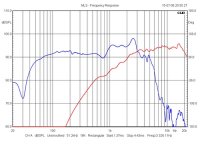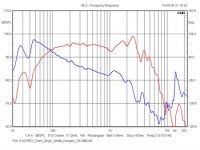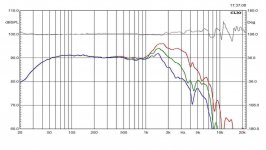Raymondj I am not an expert, but I think I have around 10 pairs of old speakers using old Vifa based paper woofers. In my view several of the old Vifa 6,5 and 8 inch woofers has that special tone or sound to it. Like Snell AX 2, Living Voice and the original Dali 104.
I also think much of the sound comes from crossoverdesign in that they use as much as possible of the bandwith of woofer, and just a few "helping" components to roll it off beyond that point.
I have removed rubber surround and replaced it with foam surround on both 6,5 and 8 inch Vifas and the improvement of midrange is substancial.
So my take on what makes them sound so good is this: Reasonably shallow, lightweight curvilinear cone, foam surround, paper voicecoil former.
I don't think they are sprayed with magical dust, just good engeneering. Their biggest downfall is the power handling.
Troels Gravesen talks about SB Acoustics Satori, SS Elipticor and 18W 8542-10 being this centuarys upgraded Vifa equivalent, but I have to disagree. In my view the closest thing in production today would be Mark Audio Alpair 12PW, but I have never heard them....
I also think much of the sound comes from crossoverdesign in that they use as much as possible of the bandwith of woofer, and just a few "helping" components to roll it off beyond that point.
I have removed rubber surround and replaced it with foam surround on both 6,5 and 8 inch Vifas and the improvement of midrange is substancial.
So my take on what makes them sound so good is this: Reasonably shallow, lightweight curvilinear cone, foam surround, paper voicecoil former.
I don't think they are sprayed with magical dust, just good engeneering. Their biggest downfall is the power handling.
Troels Gravesen talks about SB Acoustics Satori, SS Elipticor and 18W 8542-10 being this centuarys upgraded Vifa equivalent, but I have to disagree. In my view the closest thing in production today would be Mark Audio Alpair 12PW, but I have never heard them....
Last edited:
Cbarth, me too. I am not an expert.
Its a very dangerous term in this field, there are masses of things that need to be understood, along with the time to devote to the study and production of something.
You care enough about sound to experiment, and the drivers you have listed show that you are treading a similar path to myself and many others.
Interestingly, I did see the Dali 104 morph into a living voice loudspeaker years ago. So, yes, the 6.5 midwoofer is another good one to add to the list. Two of those drivers in D'appolito configuration seem to work very well and gained commercial success.
Its a very dangerous term in this field, there are masses of things that need to be understood, along with the time to devote to the study and production of something.
You care enough about sound to experiment, and the drivers you have listed show that you are treading a similar path to myself and many others.
Interestingly, I did see the Dali 104 morph into a living voice loudspeaker years ago. So, yes, the 6.5 midwoofer is another good one to add to the list. Two of those drivers in D'appolito configuration seem to work very well and gained commercial success.
Their biggest downfall is the power handling.
Just looked at the datasheet and the power handling for the Vifa M21WG-09-08 is 50w nominal, and 70w music power (whatever that means?). I was told that the xmax is 3mm but I don't know how accurate that figure is, I do know that they go plenty loud enough for most people when used in a small, sealed box (JPW AP2 sized), and the max mechanical excursion is a lot more than 3mm.
I took a pair of my own diy speakers to a show using the same woofer but in a much bigger 48ltr, sealed box (stuffed to give a Q of 0.85). Even in this big box they play most music VERY loud and only the odd track catches them out. In the smaller box that they are usually used in, they would play much louder but with less low frequency extension.
Mine are the bright red speakers:
HiFI Wigwam Show 2015 - 2016
I have these Qln Qubic 121 which has a single Vifa 17WH with rubber surround. And in the 12 litre low tuned cabinet, they can go really loud before coil travel becomes an issue. The same woofer in the floorstanding version runs out of steam a lot sooner.
One shouldn't underestimate the effect of cabinet volume loading the woofer.
Just don't over do it. I have tried that as well. I put a low Q 5 inch woofer in a really small volume with no high psss, and a 8 inch woofer crossed passive at about 150hz. Thought that the cabinet loading would offer enough protection looking at excursion in Winisd.
Well it did in normal situations, but at higher volume and deep, lasting notes it started this rocking motion. Ultimately ruined the woofer.
An externally hosted image should be here but it was not working when we last tested it.
An externally hosted image should be here but it was not working when we last tested it.
One shouldn't underestimate the effect of cabinet volume loading the woofer.
Just don't over do it. I have tried that as well. I put a low Q 5 inch woofer in a really small volume with no high psss, and a 8 inch woofer crossed passive at about 150hz. Thought that the cabinet loading would offer enough protection looking at excursion in Winisd.
Well it did in normal situations, but at higher volume and deep, lasting notes it started this rocking motion. Ultimately ruined the woofer.
Matt (fatmarley), when are we going to see the filter with your splendid VIfa project? Enquiring minds want to know! 😀
I won't be making any fresh sawdust for a couple of months due to moving home. But I'm currently interested in a Spendor BC1 type, which makes it easier to deal with midbass breakup:
Spendor BC1
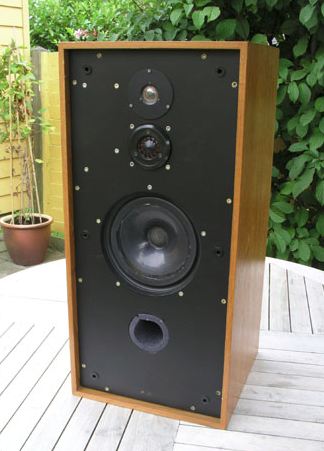
But I thought I'd try some of planet10's fullrangers as tweeter:

He recommends the Markaudio CHN-50 as very affordable and competent. Then add a little 3/4" supertweeter. How hard can it be?
CHN-50 full range driver | KJF Audio
Interestingly the Heybrook HB1 put the tweeter in its own enclosure, which might be a goodish idea to protect it from the bass backwave.
Michael Chua has used the bigger magnet Vifa M21WO-39-08:
Junco (HiVi TN28 + Vifa M21WO-39-08) – AmpsLab
I like Michael's stuff. He fancies this driver with the CAT378 horn tweeter, which sounds quite satisfactory on a mere 5.6uF capacitor allegedly. You can email him for the crossover. Can't be wildly different for the small magnet midbass. You'd just put a small coil in front of the bass to adjust to steeper rolloff.
BTW, you are right that 1.8mH is a big bass coil, and I prefer a smaller 1mH one, but friends always think it sounds bass light.
I won't be making any fresh sawdust for a couple of months due to moving home. But I'm currently interested in a Spendor BC1 type, which makes it easier to deal with midbass breakup:
Spendor BC1
But I thought I'd try some of planet10's fullrangers as tweeter:

He recommends the Markaudio CHN-50 as very affordable and competent. Then add a little 3/4" supertweeter. How hard can it be?
CHN-50 full range driver | KJF Audio
Interestingly the Heybrook HB1 put the tweeter in its own enclosure, which might be a goodish idea to protect it from the bass backwave.
Michael Chua has used the bigger magnet Vifa M21WO-39-08:
Junco (HiVi TN28 + Vifa M21WO-39-08) – AmpsLab
I like Michael's stuff. He fancies this driver with the CAT378 horn tweeter, which sounds quite satisfactory on a mere 5.6uF capacitor allegedly. You can email him for the crossover. Can't be wildly different for the small magnet midbass. You'd just put a small coil in front of the bass to adjust to steeper rolloff.
BTW, you are right that 1.8mH is a big bass coil, and I prefer a smaller 1mH one, but friends always think it sounds bass light.
That sounds interesting! Looking forward to see your project.
I already have the plans for Junco, Finch, Starling II and Starling TA. 🙂
More than 1 cap for the tweeter though.
I actually had a project that worked really well with only 2 components in the entire crossover. 2 Vifa C17WH in paralell and Seas 27TFFC in Visaton WG148 waveguide. 1mH coil and a 2,7uF cap. That was it. Sounded actually very nice 😀
I have a few plans myself when we cross over for 2020. I have 4 Seas U18 on the way, my plan is to mate them with Seas 27TDFC in Visaton Waveguide and build a rather large mtm standmount. And I will defenitely make some more Vifa projects.
I already have the plans for Junco, Finch, Starling II and Starling TA. 🙂
More than 1 cap for the tweeter though.
I actually had a project that worked really well with only 2 components in the entire crossover. 2 Vifa C17WH in paralell and Seas 27TFFC in Visaton WG148 waveguide. 1mH coil and a 2,7uF cap. That was it. Sounded actually very nice 😀
I have a few plans myself when we cross over for 2020. I have 4 Seas U18 on the way, my plan is to mate them with Seas 27TDFC in Visaton Waveguide and build a rather large mtm standmount. And I will defenitely make some more Vifa projects.
System7 could I ask another favor?
Looking at the Junco crossover, it is very similar to some of the simulations you have shown. It's just a smidge higher in frequency by the look of it. The picture shows 1,3mH seies inductor and 6,8uF/4,7ohm resistor shunting. What would you recomend for the Monacor HT22/8?

Looking at the Junco crossover, it is very similar to some of the simulations you have shown. It's just a smidge higher in frequency by the look of it. The picture shows 1,3mH seies inductor and 6,8uF/4,7ohm resistor shunting. What would you recomend for the Monacor HT22/8?

You can look at myriad simulations and you can spend days listening to the next e12 or E24 value in the series. Only one will sound right for your ears and your room, then balance that with your collection of 6000 tracks +.
Once you make a speaker for distribution without L pad controls you are committed in stone to that design. The user will then have to move his speakerit around his room, or buy new furnishings to affect changes. Can they hear less than 1 dB change?
Maybe a new Gustav Klimt on the far wall will help flatten the response between 1-2khz
The story continues.
Once you make a speaker for distribution without L pad controls you are committed in stone to that design. The user will then have to move his speakerit around his room, or buy new furnishings to affect changes. Can they hear less than 1 dB change?
Maybe a new Gustav Klimt on the far wall will help flatten the response between 1-2khz
The story continues.
I just can't wrap my head around the 1500hz peak on the M21WG. All the C and M versions of the 17/18/20/21 woofers I have come across has been super smooth. I don''t think it is cone breakup. My suspicion is it has to do with the surround. Scanspeak says it is foam surround that cannot rot. Maybe not foam then?
Look at Troels efforts on the high efficiency page were he changes from rubber to foam surround. The foam helps on the response.
Look at Troels efforts on the high efficiency page were he changes from rubber to foam surround. The foam helps on the response.
Attachments
Fatmarley thank you for your link.
A very smart solution, with a horn loaded tweeter. They look well finished and good in red.
A very smart solution, with a horn loaded tweeter. They look well finished and good in red.
Cbarth,
Looking at your plots I think they are from a test baffle as you have no baffle step?
I think once in the speaker, and the baffle step is implemented in the crossover the lump is very much flattened.
When you try an inductor for a day and think I will go up one more value you will ultimately be adjusting all these little bumps/ripples , but at the same time you are changing your crossover phase matching.
There are many possible solutions, its all part of the compromise. The cabinet stuffing can also be used to make subtle changes.
Looking at your plots I think they are from a test baffle as you have no baffle step?
I think once in the speaker, and the baffle step is implemented in the crossover the lump is very much flattened.
When you try an inductor for a day and think I will go up one more value you will ultimately be adjusting all these little bumps/ripples , but at the same time you are changing your crossover phase matching.
There are many possible solutions, its all part of the compromise. The cabinet stuffing can also be used to make subtle changes.
I'm still not convinsed. Look at these othe woofers, measured under the same conditions.
SS 22W 8534:

Monacor SPH 220HQ:

Peerless 830869:

Just thinking out loud here. The Vifa woofers normally has a QMS of 1,5 to 2,5, no kapton or glassfiber voicecoil formers. So how can the M21WG have considerably higher QMS?
And to have a such a light weight cone giving that low FS and high VAS. For that you need a high compliance suspension.
But by nature foam surrounds is a low compliance device.
The suspension has two elements, the spider and the surround. Now since the surround is a low compliance device, could they have done something to the spider?
SS 22W 8534:

Monacor SPH 220HQ:

Peerless 830869:

Just thinking out loud here. The Vifa woofers normally has a QMS of 1,5 to 2,5, no kapton or glassfiber voicecoil formers. So how can the M21WG have considerably higher QMS?
And to have a such a light weight cone giving that low FS and high VAS. For that you need a high compliance suspension.
But by nature foam surrounds is a low compliance device.
The suspension has two elements, the spider and the surround. Now since the surround is a low compliance device, could they have done something to the spider?
Fatmarley thank you for your link.
A very smart solution, with a horn loaded tweeter. They look well finished and good in red.
Thank you. I really need to revisit the crossover because I've learned a lot since I built them. They are bit harsh in the midrange and a bit dark sounding compared to my JPW AP2.
Just thinking out loud here. The Vifa woofers normally has a QMS of 1,5 to 2,5, no kapton or glassfiber voicecoil formers. So how can the M21WG have considerably higher QMS?
And to have a such a light weight cone giving that low FS and high VAS. For that you need a high compliance suspension.
But by nature foam surrounds is a low compliance device.
The suspension has two elements, the spider and the surround. Now since the surround is a low compliance device, could they have done something to the spider?
I added a bucking magnet to the M21WG to see what would happen. Obviously QES goes down, but so does QMS.
The Vifa M21WO which has more or less the same cone, just a bigger voicecoil which give a mass of about 10 grams more. It has about the same fs and a little less vas than the M21WG.
10 grammes is a big difference between the two. Which one has the sharpest low frequency resonance?
Sorry I can't look now need to tidy up.
Sorry I can't look now need to tidy up.
I'm not sure what you mean. The WG version has higher QMS so the impedance peak at resonanse is higher.
It was a general question that's all,
You have answered it by saying that the WG version has the higher QMS value and that the peak at resonance is higher.
Is it a resonance due to an un doped dust caps, I am guessing the others have larger and maybe different material dustcaps?
You have answered it by saying that the WG version has the higher QMS value and that the peak at resonance is higher.
Is it a resonance due to an un doped dust caps, I am guessing the others have larger and maybe different material dustcaps?
I was mulling this over. It's not the most promising 8" midbass I have ever seen:
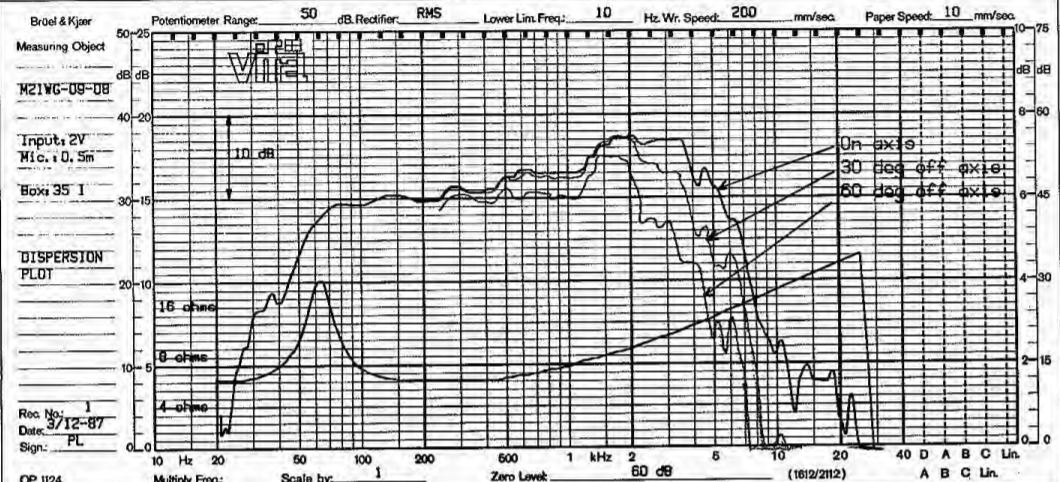
Vifa M21WG-09-08 Woofer - Heybrook HB1, JPW P1, AP2, AP3 replacement
Don't like the high Qts. Don't like that peak above 1.5kHz.
If we have the right filter here, I don't think much of this either:

It's just your usual commercial (simplistic) 6dB crossover. Phase alignment is awful.
Overdrives the tweeter. Loads of bass cone breakup above 3kHz. Waste of time! 😱
Here's how filters should work:
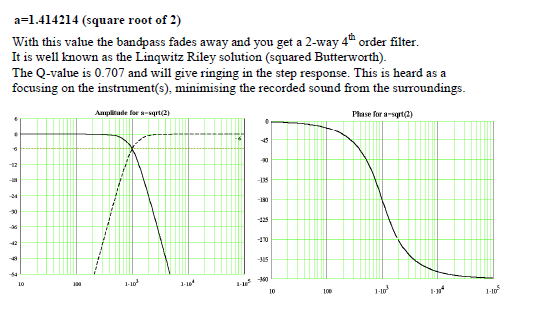
This Wharfedale Shelton XP2 has an excellent steep 12dB/octave bass filter, IMO:
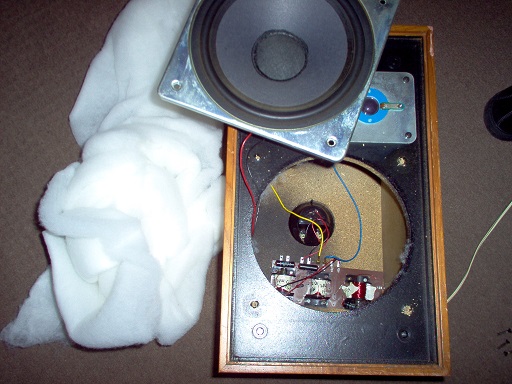
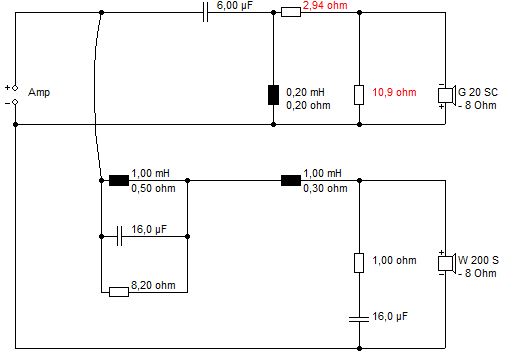
I was just modelling that in Boxsim and tried a third and fourth order negative polarity 3kHz tweeter filter.
Because 2nd order tweeter is a bit rubbish.
Which I went into HERE, if you aren't familiar with these sort of things.
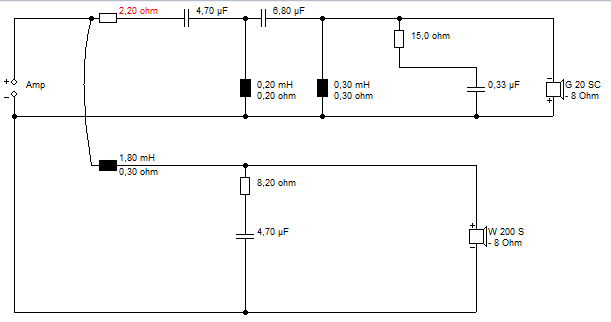
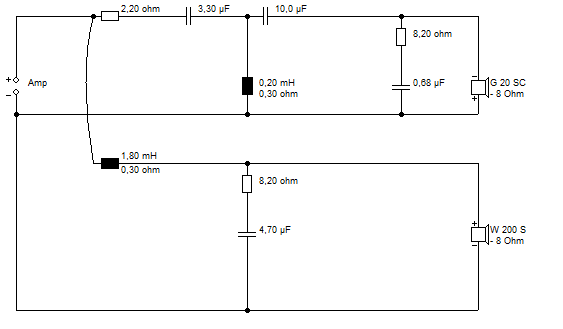
Works like a dream! If you want to know how to get impedance good, try the third and fourth order butterworth filters here: 2-Way Crossover Calculator / Designer
Butterworth tends to flat impedance! So what I am saying is use the XP2 bass section, and a third or fourth order tweeter at 3kHz negative polarity.
I think it'll work with a bit of fine tuning. For instance, use convenient 15uF rather than 16uF. Won't matter at all!
p.s. Sorry about the large images. Couldn't fix that...
Vifa M21WG-09-08 Woofer - Heybrook HB1, JPW P1, AP2, AP3 replacement
Don't like the high Qts. Don't like that peak above 1.5kHz.
If we have the right filter here, I don't think much of this either:
It's just your usual commercial (simplistic) 6dB crossover. Phase alignment is awful.
Overdrives the tweeter. Loads of bass cone breakup above 3kHz. Waste of time! 😱
Here's how filters should work:
This Wharfedale Shelton XP2 has an excellent steep 12dB/octave bass filter, IMO:
I was just modelling that in Boxsim and tried a third and fourth order negative polarity 3kHz tweeter filter.
Because 2nd order tweeter is a bit rubbish.
Which I went into HERE, if you aren't familiar with these sort of things.
Works like a dream! If you want to know how to get impedance good, try the third and fourth order butterworth filters here: 2-Way Crossover Calculator / Designer
Butterworth tends to flat impedance! So what I am saying is use the XP2 bass section, and a third or fourth order tweeter at 3kHz negative polarity.
I think it'll work with a bit of fine tuning. For instance, use convenient 15uF rather than 16uF. Won't matter at all!
p.s. Sorry about the large images. Couldn't fix that...
Last edited:
- Home
- Loudspeakers
- Multi-Way
- JPW P1 rebuild/mods
